Kyoto’s Fushimi Inari-taisha and Kiyomizu-dera are two of the city’s most iconic destinations, connected by a picturesque heritage path. Visitors can enjoy the serenity of the vermilion torii gates, explore smaller shrines, and be rewarded with breathtaking views from the hilltop temple. This journey not only showcases Kyoto’s rich cultural tapestry but also invites deeper reflection on Japan’s spiritual heritage. What secrets and stories does this path hold?
Key Points
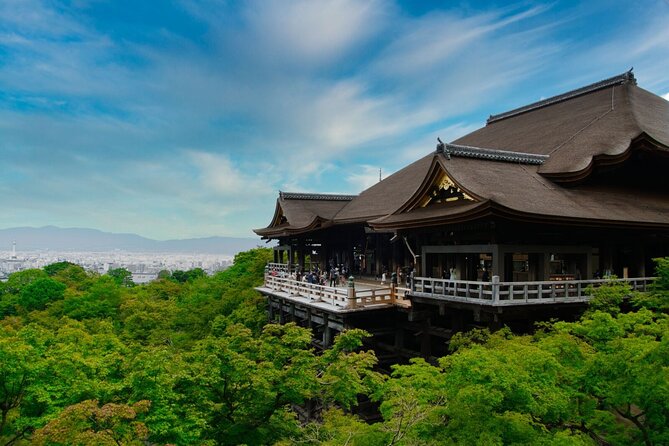
-
Explore the iconic Fushimi Inari-taisha shrine and its significance as a Shinto pilgrimage site with over 10,000 striking vermilion torii gates.
-
Visit the renowned Kiyomizu-dera temple, perched on a hillside, offering breathtaking views of Kyoto and a deep understanding of Japan’s cultural heritage.
-
Discover the Sanjusangendo temple, famous for its 1,001 statues of the Buddhist deity Kannon, showcasing intricate craftsmanship.
-
Enjoy the tranquil gardens and impressive architecture of the Kodai-ji temple, providing a peaceful respite.
-
Familiarize yourself with Kyoto’s efficient transportation network and cultural etiquette to enhance your exploration of the city’s spiritual and historical sites.
Kyoto’s Storied Past

Although Kyoto has long been recognized as the cultural capital of Japan, the city’s storied past stretches back centuries. Serving as the imperial capital for over a millennium, Kyoto is home to an abundance of historic sites and time-honored traditions.
From the famous Kiyomizu-dera temple to the iconic torii gates of Fushimi Inari-taisha, the city’s heritage is woven into the fabric of daily life. Visitors can enjoy Kyoto’s captivating history, exploring the intricate network of temples, shrines, and palaces that have shaped the nation’s cultural identity over generations.
You can also read our reviews of more tours and experiences in Kyoto.
Spiritual Pilgrimage to Fushimi Inari
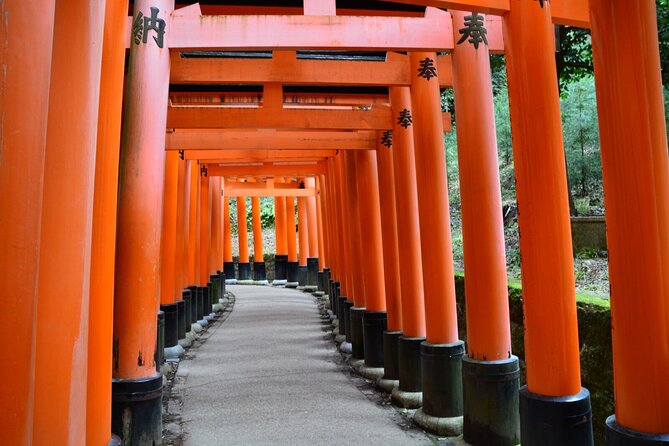
The tour begins at Fushimi Inari-taisha, the iconic Shinto shrine known for its breathtaking vermilion torii gates that wind up the mountainside.
Pilgrims embark on a spiritual journey, ascending through a forest of over 10,000 gates. Along the way, they’ll encounter:
- Smaller shrines and statues honoring Inari, the god of rice, prosperity, and business.
- Peaceful spots perfect for meditation and reflection.
- Stunning views overlooking Kyoto’s cityscape.
- The famous "tunnel of torii gates", a visually striking and serene section of the path.
The tour culminates at the historic Kiyomizu-dera temple, a UNESCO World Heritage site offering panoramic views of Kyoto.
Symbolic Significance of the Torii Gates
As visitors ascend through the vermilion torii gates of Fushimi Inari-taisha, they’ll encounter the symbolic significance of these iconic structures. The torii gates represent the transition from the mundane to the sacred, marking the entrance to the shrine’s hallowed grounds. Their vivid red color symbolizes vitality and good fortune, while their distinct architectural design evokes a connection to Japan’s Shinto spiritual heritage. The table below highlights the key symbolic meanings associated with the torii gates:
| Symbolism | Meaning |
|---|---|
| Transition | Passage from profane to sacred |
| Purification | Cleansing before entering holy space |
| Connection | Link between human and divine realms |
| Vitality | Vibrant red color signifies life and prosperity |
Discovering the Shrines and Temples
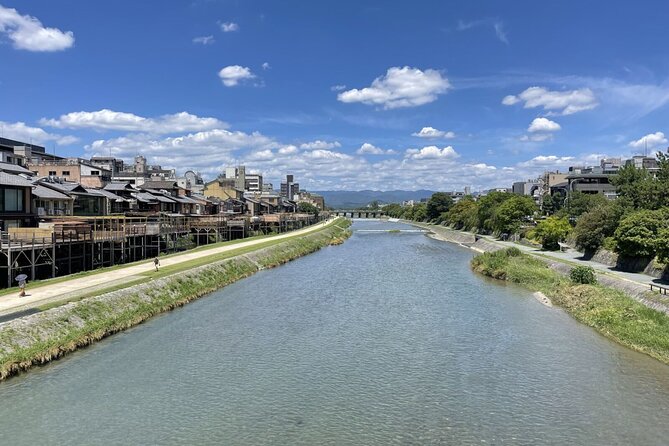
After passing through the iconic torii gates of Fushimi Inari-taisha, visitors embark on a captivating journey through Kyoto’s rich tapestry of shrines and temples.
The guided tour leads them to:
- Fushimi Inari-taisha, the iconic shrine known for its thousands of vibrant vermilion torii gates.
- Sanjusangendo, a Buddhist temple famous for its 1,001 statues of the Kannon deity.
- Kiyomizudera, a stunning wooden temple set on a hillside, offering breathtaking views of the city.
- Kodai-ji, a Zen temple renowned for its beautiful gardens and architecture.
These sacred sites offer a profound understanding of Japan’s spiritual and cultural heritage.
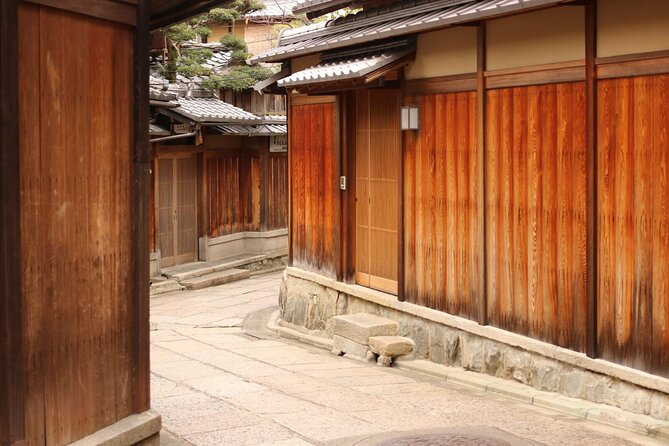
How do the winding paths of the Kyoto Heritage Tour lead visitors through the city’s rich cultural landscape?
The tour expertly navigates these paths, guiding guests from the iconic Fushimi Inari Shrine to the renowned Kiyomizu Temple. Along the way, the English-speaking guide shares insights into Kyoto’s history and architecture, bringing the city’s heritage to life.
Participants traverse cobblestone streets, ascend the slopes of wooded hillsides, and descend into the vibrant Higashiyama district, seeing the timeless ambiance that has captivated travelers for centuries.
The winding routes offer a seamless exploration of Kyoto’s most iconic landmarks and hidden gems.
Panoramic Views From Kiyomizu Temple
The tour culminates at the revered Kiyomizu Temple, where visitors are rewarded with breathtaking panoramic views of Kyoto’s landscapes.
The temple’s impressive wooden veranda, supported by imposing pillars, overlooks a picturesque valley below.
From this vantage point, travelers can:
- Gaze upon the vibrant red torii gates of Fushimi Inari Shrine in the distance.
- Spot the iconic Kyoto Tower rising above the city skyline.
- Admire the lush greenery of the surrounding hills and mountains.
- Witness the serene flow of the Kamo River winding through the cityscape.
This awe-inspiring vista provides the perfect conclusion to the Kyoto Heritage Path tour.
Exploring the Neighborhood’s Charms
As visitors ascend the iconic Kiyomizu Temple, they are greeted by the charming neighborhood that surrounds this revered site. Narrow streets lined with traditional machiya townhouses, quaint shops, and family-owned restaurants invite exploration. A tempting array of local delicacies and handicrafts await discovery.
| Explore | Shop | Dine | Discover |
|---|---|---|---|
| Traditional architecture | Handcrafted souvenirs | Kyoto-style cuisine | Historic temples and shrines |
| Artisan workshops | Unique gifts | Matcha tea houses | Scenic overlooks |
| Local festivals and events | Antique markets | Family-owned eateries | Maiko and geisha culture |
| Scenic alleyways and lanes | Specialty food and sweets | Cozy cafes | Inspiring city views |
Practical Tips for Your Kyoto Journey
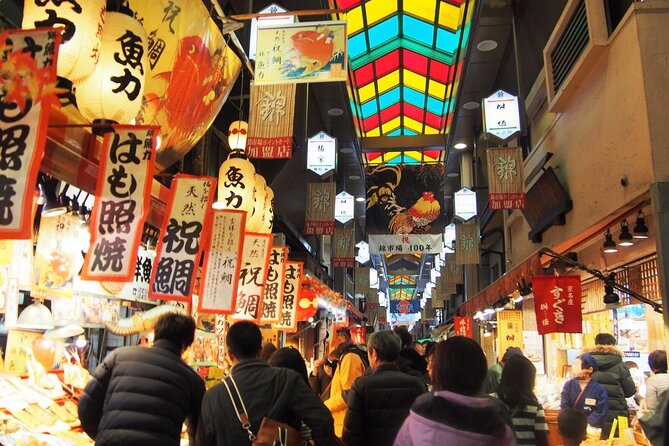
Travelers visiting Kyoto can maximize their experience by heeding a few practical tips.
Familiarize yourself with the city’s efficient train network to navigate with ease. Pack lightweight, comfortable attire suitable for Kyoto’s four seasons. Carry small bills and coins for smooth transactions at local shops and eateries.
Finally, be mindful of cultural etiquette, such as removing shoes when entering shrines and temples.
Frequently Asked Questions
Is Photography Allowed Throughout the Entire Tour?
Photography is generally allowed throughout the tour, but participants should be mindful of respecting any restrictions at the various sites visited. Travelers should check with the guide for any specific photography guidelines during the experience.
What Is the Dress Code for the Tour?
The tour has a casual dress code. Comfortable walking shoes and weather-appropriate clothing are recommended, as the tour involves walking through scenic areas. Visitors should dress modestly, as some sites may have specific dress requirements.
Are Any Food/Beverage Breaks Included During the Tour?
The tour does not include any scheduled food or beverage breaks. Participants are responsible for bringing their own snacks and drinks as desired during the self-guided portions of the experience.
Can the Tour Be Customized for Individuals With Disabilities?
The tour is not wheelchair accessible, as stated in the Additional Information. However, the provider may be able to accommodate individuals with disabilities if notified in advance. Travelers should contact the provider to discuss any special needs.
Is There an Option to Extend the Tour Duration?
The tour does not offer an option to extend the duration. However, visitors with special needs can inquire about customizing the experience to accommodate their requirements by contacting the tour provider, Snow Monkey Resorts Tours, prior to booking.
The Sum Up
The Kyoto Heritage Path offers a spellbinding journey that immerses visitors in the city’s rich cultural and spiritual tapestry. From the iconic Fushimi Inari shrine to the breathtaking Kiyomizu-dera, this route showcases Kyoto’s historical significance and invites reflection on Japan’s enduring traditions. Whether you’re seeking a spiritual pilgrimage or a chance to explore the neighborhood’s hidden charms, this path promises an unforgettable experience.
More Historical Tours in Kyoto
- 6-Hour Private Walking Cultural Tour in Kyoto
- Authentic Kyoto Guided Tour With A History and Culture Expert
- Kyoto Bus Tour : World Heritage & Special Experience【Wo】
- Full Day Guided Kyoto Cultural Tour
- Experience Authentic Gion Geisha/Maiko Cultural Tour
- Guided Gion Tour: Explore Kyoto’s Historic Geisha District
More Tour Reviews in Kyoto
- Kyoto: Discover Every Bit of Ginkakuji Temple in 60 Minutes
- Private Full-Day Walking Tour of Kyoto
- Hidden Temples in Kyoto a Self-Guided Zen Tour
- 2 Hour Private Tour of Arashiyama Highlights
- Nara 9hr Tour Licensed Guide&Vehicle: Kyoto Pickup/Osaka Dropoff
- Kyoto: Half-Day Private Tour Gion Geisha Districts & Kiyomizu
Not for you? Here's more nearby things to do in Kyoto we have reviewed
- Kyoto: Discover Every Bit of Ginkakuji Temple in 60 Minutes
- Private Full-Day Walking Tour of Kyoto
- Hidden Temples in Kyoto a Self-Guided Zen Tour
- 2 Hour Private Tour of Arashiyama Highlights
- One Way Bus From Kanazawa to Kyoto
- Nara 9hr Tour Licensed Guide&Vehicle: Kyoto Pickup/Osaka Dropoff
- Original Pizza Making Using Kyoto Vegetable at BNR Night Farm
- Kyoto 8 Hr Tour From Osaka: English Speaking Driver, No Guide
- Kyoto: Half-Day Private Tour Gion Geisha Districts & Kiyomizu
- Kyoto Sweets & Desserts Tour With a Local Foodie: Private & Custom
- Arashiyama Autumn Leaves & Sanzen-In Temple Tour From Osaka/Kyoto
- Kyoto: Top Sake Region Tour – 2.5 Hours, 3 Tasting Spots
